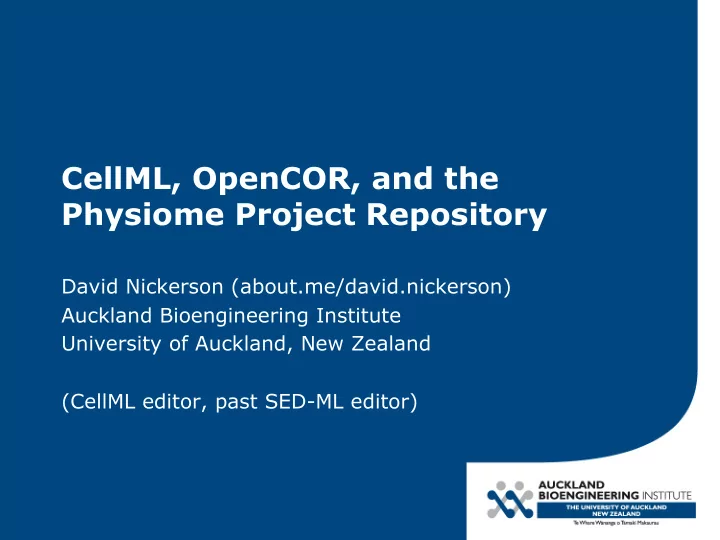

CellML, OpenCOR, and the Physiome Project Repository David Nickerson (about.me/david.nickerson) Auckland Bioengineering Institute University of Auckland, New Zealand (CellML editor, past SED-ML editor)
• Store and exchange computer-based mathematical models. • Allows for modular encoding of models. • Provides a method to reuse modules. • Aim for an unambiguous description of the mathematical model. • Biology pushed off into annotations. • http://cellml.org 2
Modularity & reuse in CellML • CellML provides the framework for encoding mathematical models in a very modular manner – separation of mathematical model and a specific instance of the model (parameterization). – unambiguous definition of all physical quantities to allow automated translation between units across connections. • Following some best practice guidelines ensures the modules are “easily” reusable by the widest possible audience. • Some examples… 4
5
6
7
8
The Physiome Project Repository • http://models.physiomeproject.org • A freely accessible site for researchers to find, store, and share models and associated data. • Currently contains over 500 published models encoded in CellML, and some examples of FieldML models – and many works in-progress! • Powered by the PMR2 software framework. 9
PMR2 Workspaces • A collection of one or more related resources in the repository. • Version controlled, every revision to a workspace is recorded as a changeset: – is an immutable representation of the contents of the workspace; – is a complete and unambiguous record of the workspace evolution; – has a unique URL for citation; – is linked to authors responsible for changes. • Enables accurate provenance tracking. • Can be nested to take advantage of modularity and reuse 10
11
PMR2 Exposures • Data in the repository can be presented through exposures. • An exposure is a permanent link to a specific workspace changeset. • Data are rendered in a format suitable for presentation in the web interface of the PMR2 instance. • Rendering of specific data types is managed by an extensible plug-in based system. • Exposures are obvious objects for curation as they are immutable references to specific revisions of the data contained in a workspace. 12
13
14
http://opencor.ws 15
OpenCOR • The combination of OpenCell and COR tools. • Will be a comprehensive modeling environment, initially using CellML but extensible to other standards (SED-ML and SBML desirable targets). • Plugin-based architecture. • Current capabilities focused on the simulation and annotation of CellML models. 16
17
18
19
20
eSolv • A CellML-based simulation front-end for online teaching – http://www.esolv.nl/ 21
CSim • A minimal stand-alone simulation tool for CellML models that works on Linux, Mac, and Window. • https://code.google.com/p/cellml-simulator/ • Used by: – SED-ML Web Tools – eSolv – GET (https://bitbucket.org/get) – Gib’s multi-cell agent-based simulation tool 22
Wnt-CyclinD (??) 23
Acknowledgements • Virtual Physiological Rat Project, NIH grant [P50- GM094503] • VPH Network of Excellence – Project ID (FP7- ICT-223920) • EuHeart • The Maurice Wilkins Centre for Molecular Biodiscovery • RICORDO – Project ID (FP7-ICT-248502) • More information, tutorial up at: http://vph2014-abi-tutorial.readthedocs.org/en/latest/ (or come along this afternoon to session 1(b)) 24
Recommend
More recommend